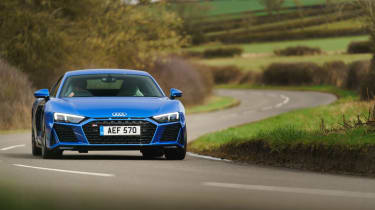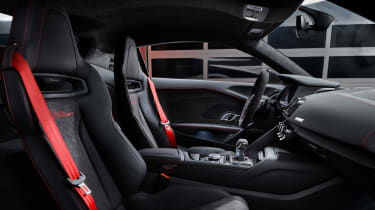Audi R8 review – interior and tech
The R8's cabin feels refreshingly simple in 2023, with intuitive controls and no screens tacked onto the dashboard
The high-quality cabin might be slightly conservative in its design, but the layout is very intuitive and the seating position and view through the windscreen are very evocative, setting just the right tone, and the quality of the materials used is up there with the best. There’s a useful storage area behind the seats, as well as the deep stowage compartment in the nose of the car.
The cabin is dominated by the Virtual Cockpit, which locates all of the entertainment and navigation screens within the instrument binnacle, along with the rev counter and speedometer. The entire area within the binnacle is a TFT screen, which allows the driver to choose between a number of display options, from a full size map to a big, central rev counter.
Audi Connect – 4G-enbaled internet connectivity – enables the driver to stream music, access weather, traffic or flight information and also acts as a hotspot for personal mobile devices. Virtual Cockpit and Audi Connect put the R8 right at the front of the class for tech and connectivity. Best of all, everything works well, and works predictably – there are advantages, it seems, to a supercar built by the same people that make posh family cars and repmobiles.
A number of members of the evo editorial team found the optional Recaro-shelled bucket seats (£3000) to be less comfortable than the standard seats without offering much more lateral support. That's exacerbated in the Spyder, whose different roof layout forces the rearmost seating position forward and can make things exceptionally uncomfortable for taller drivers. Despite its stripped back ambience, the R8 GT RWD has the same Recaros available in lesser models, albeit trimmed in grippier suede upholstery with red stitching and seatbelts.





